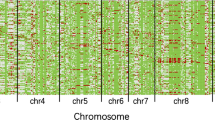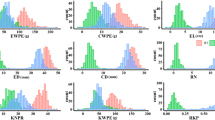Abstract
The genetic basis of heterosis for grain yield and its components was investigated at the single- and two-locus levels using molecular markers with an immortalized F2 (IF2) population, which was developed by pair crosses among recombinant inbred lines (RILs) derived from the elite maize hybrid Yuyu22. Mid-parent heterosis of each cross in the IF2 population was used to map heterotic quantitative trait loci. A total of 13 heterotic loci (HL) were detected. These included three HL for grain yield, seven for ear length, one for ear row number and two for 100-kernel weight. A total of 143 digenic interactions contributing to mid-parent heterosis were detected at the two-locus level involving all three types of interactions (additive × additive = AA, additive × dominance = AD or DA, dominance × dominance = DD). There were 25 digenic interactions for grain yield, 36 for ear length, 31 for ear row number and 51 for 100-kernel weight. Altogether, dominance effects of HL at the single-locus level as well as AA interactions played an important role in the genetic basis of heterosis for grain yield and its components in Yuyu22.

Similar content being viewed by others
References
Bruce AB (1910) The Mendelian theory of heredity and the augmentation of vigor. Science 32:627–628
Carlborg Ö, Haley CS (2004) Epistasis: too often neglected in complex trait studies? Nat Rev Genet 5:618–625
Cockerham CC (1954) An extension of the concept of partitioning hereditary variance for analysis of variances among relatives when epistasis is present. Genetics 39:859–882
Cockerham CC, Zeng ZB (1996) Design III with marker loci. Genetics 143:1437–1456
East EM (1936) Heterosis. Genetics 21:375–397
Frascaroli E, Canè MA, Landi P, Pea G, Gianfranceschi L, Villa M, Morgante M, Pè ME (2007) Classical genetic and quantitative trait loci analyses of heterosis in a maize hybrid between two elite inbred lines. Genetics 176:625–644
Garcia AAF, Wang SC, Melchinger AE, Zeng ZB (2008) Quantitative trait loci mapping and the genetic basis of heterosis in maize and rice. Genetics 180:1707–1724
Graham GI, Wolff DW, Stuber CW (1997) Characterization of a yield quantitative trait locus on chromosome five of maize by fine mapping. Crop Sci 37:1601–1610
Hua JP, Xing YZ, Xu CG, Sun XL, Yu SB, Zhang QF (2002) Genetic dissection of an elite rice hybrid revealed that heterozygotes are not always advantageous for performance. Genetics 162:1885–1895
Hua JP, Xing YZ, Wei WR, Xu CG, Sun XL, Yu SB, Zhang QF (2003) Single-locus heterotic effects and dominance by dominance interactions can adequately explain the genetic basis of heterosis in an elite rice hybrid. PNAS 100:2574–2579
Jones DF (1917) Dominance of linked factors as a means of accounting for heterosis. Genetics 2:466–479
Knapp SJ, Stroup WW, Ross WM (1985) Exact confidence intervals for heritability on a progeny mean basis. Crop Sci 25:192–194
Kusterer B, Muminovic J, Utz HF, Piepho H-P, Barth S, Heckenberger M, Meyer RC, Altmann T, Melchinger AE (2007a) Analysis of a triple testcross design with recombinant inbred lines reveals a significant role of epistasis in heterosis for biomass-related traits in Arabidopsis. Genetics 175:2009–2017
Kusterer B, Piepho H-P, Utz HF, Muminovic J, Meyer RC, Altmann T, Schön CC, Melchinger AE (2007b) Heterosis for biomass-related traits in Arabidopsis investigated by a novel QTL analysis of the triple testcross design with recombinant inbred lines. Genetics 177:1839–1850
Lander ES, Green P, Abrahamson J, Barlow A, Daly MJ, Lincon SE, Etoh T (1987) Mapmaker: an interactive computer package for constructing primary genetic linkage maps of experimental and natural populations. Genomics 1:174–181
Li ZK, Luo LJ, Mei HW, Wang DL, Shu QY, Tabien R, Zhong DB, Ying CS, Stansel JW, Khush GS, Paterson AH (2001) Overdominance epistatic loci are the primary genetic basis of inbreeding depression and heterosis in rice. I. Biomass and grain yield. Genetics 158:1737–1753
Lu H, Romero-Severson J, Bernardo R (2003) Genetic basis of heterosis explored by simple sequence repeat markers in a random-mated maize population. Theor Appl Genet 107:494–502
Luo LJ, Li ZK, Mei HW, Shu QY, Tabien R, Zhong DB, Ying CS, Stansel JW, Khush GS, Paterson AH (2001) Overdominance epistatic loci are the primary genetic basis of inbreeding depression and heterosis in rice. II. Grain yield components. Genetics 158:1755–1771
Melchinger AE, Piepho H-P, Utz HF, Muninovic J, Wegenast T, Törjek O, Altmann T, Kusterer B (2007a) Genetic basis of heterosis for growth-related traits in Arabidopsis investigated by testcross progenies of near-isogenic lines reveals a significant role of epistasis. Genetics 177:1827–1837
Melchinger AE, Utz HF, Piepho H-P, Zeng ZB, Schon CC (2007b) The role of epistasis in the manifestation of heterosis: a systems-oriented approach. Genetics 177:1815–1825
Powers L (1944) An expansion of Jones’s theory for the explanation of heterosis. Am Nat 78:275–280
Schön CC, Dhillon BS, Utz HF, Melchinger AE (2010) High congruency of QTL positions for heterosis of grain yield in three crosses of maize. Theor Appl Genet. doi:10.1007/s00122-009-1209-9
Shull GH (1908) The composition of a field of maize. Am Breed Assoc Rep 4:196–301
Snedecor GW, Cochran WG (1980) Statistical methods. Iowa State University Press, Ames
StatSoft (1997) Statistica. StatSoft, Tulsa
Stuber CW, Lincoln SW, Wolff DW, Helentjaris T, Lander ES (1992) Identification of genetic factors contributing to heterosis in a hybrid from two elite maize inbred lines using molecular markers. Genetics 132:823–839
Williams W (1959) Heterosis and the genetics of complex characters. Nature 184:527–530
Xiao JH, Li JM, Yuan LP, Tanksley SD (1995) Dominance is the major genetic basis of heterosis in rice as revealed by QTL analysis using molecular markers. Genetics 140:745–754
Yu SB, Li JX, Xu CG, Yan YF, Gao YJ, Li XH, Zhang QF, Saghai Maroof MA (1997) Importance of epistasis as the genetic basis of the heterosis in an elite rice hybrid. PNAS 94:9226–9231
Zeng ZB (1994) Precision mapping of quantitative trait loci. Genetics 136:1457–1468
Acknowledgments
This work was supported by a grant from the State Key Basic Research and Development Plan of China. B.S. Dhillon and A.E. Melchinger were financed by the Deutsche Forschungsgemeinschaft (DFG) within the priority program SPP 1149 "Heterosis in Plants" (Research Grant ME931/4-3). The authors appreciate Dr. Qifa Zhang for providing a computer program to analyze the digenic interactions, and Dr. J. Dudley for critical reading of the manuscript and helpful suggestions.
Author information
Authors and Affiliations
Corresponding author
Additional information
Communicated by C. Schön.
Contribution to the special issue “Heterosis in Plants”.
Electronic supplementary material
Below is the link to the electronic supplementary material.
Rights and permissions
About this article
Cite this article
Tang, J., Yan, J., Ma, X. et al. Dissection of the genetic basis of heterosis in an elite maize hybrid by QTL mapping in an immortalized F2 population. Theor Appl Genet 120, 333–340 (2010). https://doi.org/10.1007/s00122-009-1213-0
Received:
Accepted:
Published:
Issue Date:
DOI: https://doi.org/10.1007/s00122-009-1213-0




